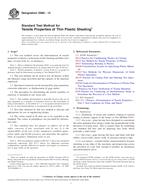We need your consent to use the individual data so that you can see information about your interests, among other things. Click "OK" to give your consent.
ASTM D5420-10
Standard Test Method for Impact Resistance of Flat, Rigid Plastic Specimen by Means of a Striker Impacted by a Falling Weight (Gardner Impact)
STANDARD published on 1.7.2010
The information about the standard:
Designation standards: ASTM D5420-10
Note: WITHDRAWN
Publication date standards: 1.7.2010
SKU: NS-31108
The number of pages: 8
Approximate weight : 24 g (0.05 lbs)
Country: American technical standard
Category: Technical standards ASTM
The category - similar standards:
Annotation of standard text ASTM D5420-10 :
Keywords:
dart impact, falling weight impact, Gardner impact, impact, impact resistance, mean-failure energy, mean-failure height, rigid plastic, Dart impact method, Failure end point--plastics, Falling weight test, Gardner impact test, Impact testing--plastics, Mean-failure energy/height/weight, Rigid plastics, Striker impact test, ICS Number Code 83.140.10 (Films and sheets)
Additional information
| Significance and Use | ||||||||||||||||||||||
|
Plastics are viscoelastic it is and therefore possible that they are sensitive to changes in velocity of weights falling on their surfaces. However, the velocity of a free-falling object is a function of the square root of the drop height. A change of a factor of two in the drop height will cause a change of only 1.4 in velocity. Hagan, et al (2) found that the mean-failure energy of sheeting was constant at drop heights between 0.30 and 1.4 m. Different materials respond differently to changes in the velocity of impact. The test conditions used in Geometry GA are the same as those used in Geometry FA of Test Method D5628 (see Table 1). The test conditions of Geometry GB are equivalent to the geometry used for the Gardner Variable Height Impact Test (3). The test conditions of Geometry GC cause a punch-shear type of failure because the support-plate hole is close to the diameter of the striker. The test conditions of Geometry GD are the same as those in Test Method D3763. The test conditions of Geometry GE are the same as those in Test Method D4226, impactor head configuration H.25. Because of the nature of impact testing, the selection of a test method and striker must be somewhat arbitrary. Consider the end use environment and requirements when choosing from the available striker geometries. However, the selection of any one of the striker geometries is permitted, after such consideration. Note 2—Material processing can have a significant affect on the development of a plastic's physical properties. Consult relevant material standards for processing guidelines |
||||||||||||||||||||||
| 1. Scope | ||||||||||||||||||||||
|
1.1 This test method covers the determination of the relative ranking of materials according to the energy required to crack or break flat, rigid plastic specimens under various specified conditions of impact of a striker impacted by a falling weight. 1.2 The values stated in SI units are to be regarded as the standard. The values given in parentheses are for information only. 1.3 This standard does not purport to address all of the safety concerns, if any, associated with its use. It is the responsibility of the user of this standard to establish appropriate safety and health practices and determine the applicability of regulatory limitations prior to use. Note 1—There is no similar or equivalent ISO standard. |
||||||||||||||||||||||
| 2. Referenced Documents | ||||||||||||||||||||||
|
Similar standards:
Historical
1.4.2010
Historical
1.2.2011
Historical
1.12.2011
Historical
15.2.2009
Historical
1.7.2008
Historical
1.8.2012
We recommend:
Technical standards updating
Do you want to make sure you use only the valid technical standards?
We can offer you a solution which will provide you a monthly overview concerning the updating of standards which you use.
Would you like to know more? Look at this page.



 ASTM D7192-10
ASTM D7192-10 ASTM D7193-11
ASTM D7193-11 ASTM D7310-11
ASTM D7310-11 ASTM D7445-09
ASTM D7445-09 ASTM D7465-08
ASTM D7465-08 ASTM D882-12
ASTM D882-12
 Cookies
Cookies
